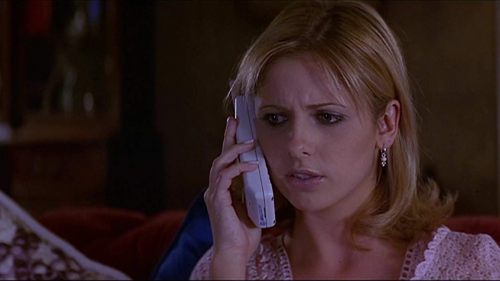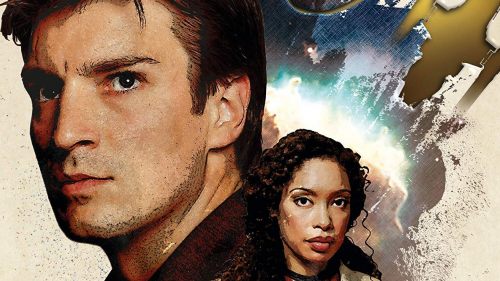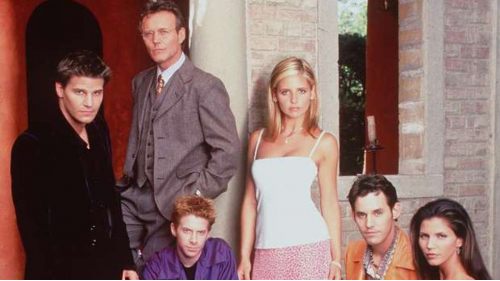Anatomy Of A Perfect Pilot: Twenty Years After “Welcome To The Hellmouth”
ANGLE: HIS NECK
Has two big ol’ bite marks in it.
What floods onto Buffy’s face is not horror, but grim frustration. She stares down at the body, nearly seething.
BUFFY
Oh, great!
On March 10, 1997, twenty years ago today, The WB aired two back-to-back episodes of a new series called, improbably, Buffy the Vampire Slayer. Joss Whedon created the series as something of a sequel to the film of the same title he’d written five years earlier. Fran Rubel Kuzui directed that film, and Whedon has spoken at length about how the final product – and character – deviated from his original ideas.
I had written this scary film about an empowered woman, and they turned it into a broad comedy. It was crushing.
[...]
I finally sat down and had written it and somebody had made it into a movie, and I felt like – ‘well, that’s not quite her. It’s a start, but it’s not quite the girl.’
Three years later, producer Gail Berman offered Whedon the opportunity to reinvent the story, and tell it the way he wanted to tell it.
They called me up out of contractual obligation: ‘Call the writer, have him pass.’ And I was like, ‘Well, that sounds cool.’ So, to my agent's surprise and chagrin, I said, ‘Yeah, I could do that. I think I get it. It could be a high-school horror movie. It'd be a metaphor for how lousy my high-school years were.’ So I hadn't had the original idea, I just developed it.
Two years after that, “Welcome to the Hellmouth” premiered on The WB to a moderate audience, with a Nielsen rating of 3.4. The pilot fared better critically, with reviewers commenting on the episode’s clever dialogue and fresh approach to the horrors of high school.
Along with its same-night successor “The Harvest,” “Welcome to the Hellmouth” launched a seven-season series, a spin-off show, a collection of comic publications, several novels, endless critical analyses online and in print, multiple video and role-playing games and, of course, one of fandom’s most impassioned audiences. From its opening hour, Buffy the Vampire Slayer connected with people.
Twenty years later, what is it about “Welcome to the Hellmouth” that lasts? Pilots aren’t an easy endeavor, and so many fail – even if their series are picked up and go on to be successful, many shows’ first episodes are considered among their weakest, and Buffy’s pilot in particular had a tough row to hoe. Introducing this unusual universe, nodding to the film that came before it for fans while quickly summarizing it for newbies, making sense of that outlandish title, delivering serious genre fare and colorful teenage insight in equal doses while still entertaining its viewers and making them laugh? That is, to quote Buffy Summers, “a job of work.”
Yet “Welcome to the Hellmouth” does all of that and plenty more with seeming ease. The narrative around Buffy the Vampire Slayer was always something of a happy accident: “Look at this little show that could! Who would’ve thought that a series about a teen vampire killer named Buffy could be so smart?” But this was no happy accident. You don’t stumble onto something like Buffy, this indelible pop culture standard, a series that has meant so much to so many people and influenced countless other stories.
Spending a little time studying “Welcome to the Hellmouth” – reading the shooting script and dozens of interviews, listening to the commentary, watching the unfortunate unaired pilot – reveals the tremendous amount of consideration that went into crafting this damn-near perfect episode of television. Whedon attempted this story twice before he got it right, and he’s continued to refine Buffy’s journey years after her show went off the air.
So let’s talk about the craft that went into that first episode, that expert introduction to a world as complex and, at the time, as almost unprecedented as Buffy’s. There’s a nuanced thesis at work under the poppy high school horror, one that’s introduced to us in the very first minutes of the pilot. We open with a pretty blonde (soon revealed to be Julie Benz’s Darla) and a sketchy-looking fella sneaking into Sunnydale High for some romantic hijinks. She’s scared; he’s delighted. We’ve seen this before. If we’re watching a show with the word “Vampire” in the title, we’re probably well-versed in horror tropes, and we know how this ends. The girl’s dead or hurt, right?
But here, it’s the fella who should be scared. Darla’s using her girlish voice and wide eyes to lure him into a dark, secluded space so she can feed on him. He convinces her that it’s safe, that there’s nobody nearby, and Darla allows herself to be comforted. “Okay,” she tells him, as her face transforms from the picture of innocence to that of a monster.
She bares HORRIBLE FANGS and BURIES them in his neck.
BLACKOUT.
END OF TEASERCREDITS
There’s your thesis, right there. Whedon has said many times that when he first conceived of Buffy Summers, his intent was to subvert the image of “the little girl, the little blonde girl who goes into a dark alley and gets killed in every horror movie.” The cold open of “Welcome to the Hellmouth” works as a quick education into this subversion, teaching us in the opening seconds to expect the unexpected before we’ve even met our main character – while doing double duty and neatly informing us of Sunnydale’s most unassailable truth: here, there be vampires.
It’s economical and effective, as are the first few moments of Act One, during which we’re brought into Buffy’s nightmares. These work as both flashbacks and foreshadowing, nodding to the events of the film for those familiar with it, hinting at the horror that’s to come while establishing an atmosphere of dread for both Buffy and the audience. These nightmares teach us that Buffy’s been dealing with monsters like Darla for quite some time now.
Because the inciting event of Buffy the Vampire Slayer, the series, isn’t that Buffy learns she’s a slayer. That’s already happened. In the parlance of the Slayer, “I have both been there and done that. I am moving on.” That’s what these dreams are telling us. Buffy knows her duty. She’s already accepted that burden and then rejected it. When Buffy wakes and we see moving boxes in her bedroom, we understand that Sunnydale is the inciting event here – the fact that her mother Joyce (Kristine Sutherland), in trying to keep Buffy from trouble, has just moved her to the Hellmouth, the place and time that a Slayer is most needed. But Buffy doesn’t know that yet. All she knows is that she’s been yanked into a new school, and as Joyce calls off-screen that Buffy doesn’t want to be late to her first day, Buffy sighs, “No, wouldn’t want that.”
These are the first five minutes of “Welcome to the Hellmouth.” In them, we’re introduced to the very philosophy that forms the foundation of Buffy the Vampire Slayer, and we’re introduced to Buffy herself, the push-and-pull that makes her Buffy. She doesn’t want to shoulder the burden of being this generation’s Chosen One, and she also doesn’t want to start a new high school where she might have trouble making friends or have “last month’s hair.” Sarah Michelle Gellar is so good in this first episode, this miraculous marriage of valley girl and superhero, funny and vulnerable, fierce and human.
Every interaction she has with another character reveals more about her: her “cool test” with Cordelia (Charisma Carpenter) reveals that Buffy is both very cool and very preoccupied with being cool, but her sweet, cheerful interactions with “losers” Xander and Jesse (Nicholas Brendan and Eric Balfour) demonstrate that it’s more important to Buffy to be kind than cool, even in the face of Cordelia’s daunting disapproval. And she is fearless with the vampires she encounters, casually tossing off one-liners as she stakes one of them without even turning around to see him fall.
When Buffy meets Angel (David Boreanaz), we see her physical agility, her lack of patience with contrived mystery and how difficult it is to cow this 5-foot-something teenage girl. Gentle Principal Flutie (Ken Lerner) is the first character who has the capacity to intimidate Buffy, because all she wants is to fit in at this school, not to be seen as the weirdo who burned down her last school’s gym.
But there are two characters whose interactions with Buffy make up the heart of “Welcome to the Hellmouth” and of Buffy the Vampire Slayer: Giles (Anthony Stewart Head) and Willow (Alyson Hannigan). (Fan-favorite Xander becomes better developed in “The Harvest” – in “Hellmouth,” he’s a charming jokester but not much more yet. We’ll see his courage very soon.)
Like Xander, Giles is better established in “The Harvest” (Angel takes a few more episodes before we figure out his deal), but we see his “quiet intensity” and goofy British-ness right away, and his surprise when Buffy tells him, in the fiercest of terms, that she has no interest in pursuing a destiny that holds nothing but heartache for her. He’s her Watcher, and he’s there to prepare her – but here Buffy cuts him off.
Prepares me for what? For getting kicked out of school? Losing all my friends? Having to spend all my time fighting for my life and never getting to tell anyone because it might ‘endanger’ them? Go ahead. Prepare me.
Giles realizes he’ll have his hands full with this one, a Slayer unlike any other in the history of vampires, but he also quickly realizes how capable Buffy is, how well-suited to this destiny she rejects. She spots a vampire based on his outdated outfit; she dispenses with every vamp she encounters, save for Luke (Brian Thompson), with a quickness. He admires her, and he also fears for the future in the hands of this fashion-obsessed teen. This relationship will go on to be vitally important to the success of Buffy the Vampire Slayer, a father-daughter dynamic that will break our hearts again and again, and the seeds of it are all here in “Welcome to the Hellmouth.”
And then there’s Willow.
WILLOW. She is shy, bookish, and very possibly dressed by her mother. The intelligence in her eyes and the sweetness of her smile belie a genuine charm that is lost on the unsubtle high school mind. It’s certainly lost on Xander, though he brightens considerably to see her.
Alyson Hannigan is a godsend in the role. She’s so slight and sweet and unpretentious that Buffy is immediately protective of her, willing to throw over her cool status with Cordelia in order to befriend this wonderful little nerd. Their best exchange – of many wonderful exchanges in the pilot – is at The Bronze, when Willow and Buffy are chatting, and Buffy excuses herself for a moment after spying Giles upstairs.
BUFFY
Uh, I’ll be back in a minute.WILLOW
That’s okay. You don’t have to come back.BUFFY
(smiling at her self-effacing attitude)
I’ll be back in a minute.
Their friendship humanizes Buffy, shows the tender heart the slayer holds underneath her snarky slang and ass-kicking. Willow also inspires protectiveness in the audience, creating real, immediate tension whenever she is in danger. As Whedon says in the commentary:
And there goes Alyson. Alyson, king of pain. When anybody attacks her, we learned early on, it just opens up your heart. It’s a terrible thing. She’s so good at playing that vulnerability.
But Willow isn’t only this sweet little victim, the perfect vampire-bait. She’s brilliant – both Buffy and Xander turn to her for tutoring help in the pilot, and we learn in “The Harvest” that she’s also scary-good at computers, and cheerfully unafraid to hack into city records. And, of course, as time goes on, we learn that Cordelia is more than the Mean Girl, and Joyce is more than the mother. We see hints of both of these journeys in “Welcome to the Hellmouth” – Joyce talks about the “positive energy” she has flowing, the gallery she’s building, how hard a new town is for both of them, but how they’ll make it work. And though there isn’t much feminist conversation around Cordelia yet in these early episodes, her interactions with Jesse – who follows her around obsessively, resents her rejection and, after turning into a vampire in “The Harvest,” attacks her – very much follow the toxic Nice Guy trajectory.
This fundamental, incontrovertible deferral to feminist ideals is the backbone of every scene, every exchange in “Welcome to the Hellmouth,” and it’s what sets Buffy the Vampire Slayer apart from nearly every other show of its time. It’s there in the script, from the very beginning, in scenes where we’re not even thinking about it.
CUT TO:
INT. WOMEN’S LOCKER ROOM – AFTERNOON
Two GIRLS approach their lockers, talking. They begin undressing (just shoes and coats and stuff. Get your mind out of the gutter.)
And it’s a reversal of that feminist opening scene that makes for a clever cliffhanger to “Welcome to the Hellmouth,” as powerful vampire Luke is the first to get the upper hand in a fight with Buffy, and scoffs that he can “handle the little girl.” He menaces over her in the crypt with “gleeful animal hunger,” and the screen blacks out as the episode tells us it’s TO BE CONTINUED.
Like any cliffhanger, it’s a good way to keep viewers hanging around for the next episode, but “Welcome to the Hellmouth” has already taught us what to expect. This little blonde girl may be down, but she’s not out. “The Harvest” will open with her overpowering Luke, saving her friends and going on to save the world. For the first of many, many times. Because that’s what Buffy does.



